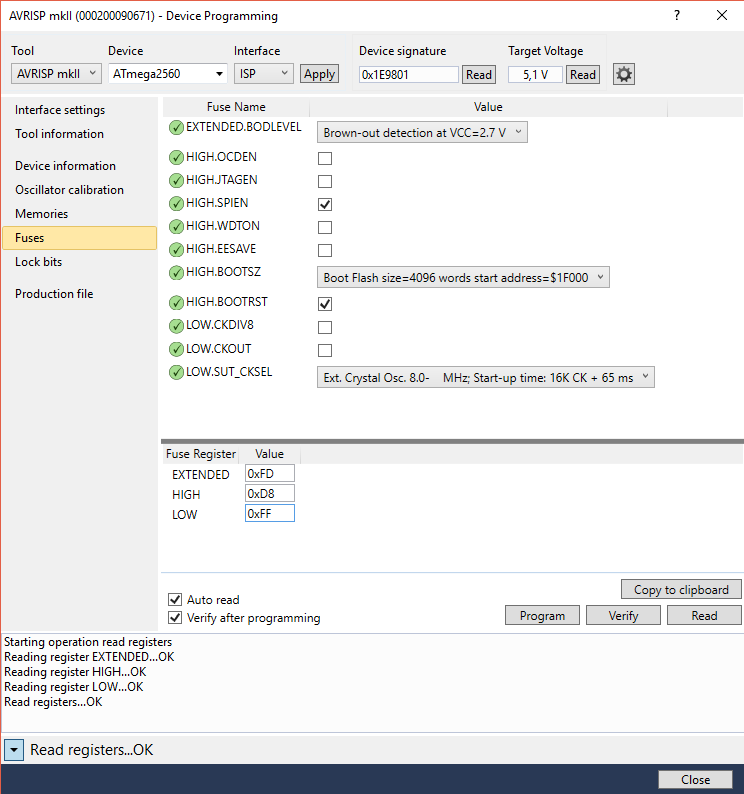I have a running application on the ATmega2560 and it is working OK. Now, I wanted to implement Watchdog feature in order to reset the chip when the application takes longer to operate for some reason.
I am using Visual Studio with Visual Micro extension. And I flash the HEX file via AVRISP mkII.
So, I have simply started with couple of samples found on the net. But, whatever WDT version I used they repeatedly restarted the chip on and on endlessly.
Here is one of them;
#include <avr/wdt.h>
int loop_count = 0;
int wdt_counter = 0;
void setup() {
Serial.begin(9600);
Serial.println("Starting up...");
pinMode(10, OUTPUT);
digitalWrite(10, HIGH);
delay(500);
watchdogStart();
}
void watchdogStart(void)
{
cli(); // disable all interrupts
wdt_reset(); // reset the WDT timer
/*
//WDTCSR configuration:
WDIE = 1: //Interrupt Enable
WDE = 1 : //Reset Enable
WDP3 = 0 :
For 2000ms Time-out WDP2 = 1 :
For 2000ms Time-out WDP1 = 1 :
For 2000ms Time-out WDP0 = 1 :
For 2000ms Time-out
*/
// Enter Watchdog Configuration mode:
WDTCSR |= (1 << WDCE) | (1 << WDE); // Set Watchdog settings:
WDTCSR = (1 << WDIE) | (0 << WDE) | (0 << WDP3) | (1 << WDP2) | (1 << WDP1) | (1 << WDP0);
sei();
}
void watchdogArm(void)
{
cli(); // disable all interrupts
wdt_reset(); // reset the WDT timer
/*
//WDTCSR configuration:
WDIE = 1: //Interrupt Enable
WDE = 1 : //Reset Enable
WDP3 = 0 :
For 2000ms Time-out WDP2 = 1 :
For 2000ms Time-out WDP1 = 1 :
For 2000ms Time-out WDP0 = 1 :
For 2000ms Time-out
*/
// Enter Watchdog Configuration mode:
WDTCSR |= (1 << WDCE) | (1 << WDE); // Set Watchdog settings:
WDTCSR = (1 << WDIE) | (1 << WDE) | (0 << WDP3) | (1 << WDP2) | (1 << WDP1) | (1 << WDP0);
sei();
}
void loop()
{
for (int i = 0; i <= loop_count; i++) {
digitalWrite(10, HIGH);
delay(100);
digitalWrite(10, LOW);
delay(100);
}
loop_count++;
wdt_reset();
watchdogStart();
wdt_counter = 0;
Serial.print(loop_count);
Serial.print(". Watchdog fed in approx. ");
Serial.print(loop_count * 200);
Serial.println(" milliseconds.");
}
/* this is called when the watchdog times out and before the reset */
ISR(WDT_vect) // Watchdog timer interrupt.
{
if (wdt_counter == 0)
{
wdt_counter++;
watchdogArm();
}
// Include your code here - be careful not to use functions they may cause the interrupt to hang and // prevent a reset.
}
I am about to conclude WDT is not really working with ATmega2560. I would like to hear your opinions and most desirably a reliable working solution sample?

